Changes in the Dog’s and Cat’s Behaviors, as Reported by the Owners, before and during the Lockdown in China
Abstract
Simple Summary
Abstract
1. Introduction
2. Materials and Methods
2.1. Survey Design
2.2. Survey Method
2.3. Statistical Analysis
3. Results
3.1. Dogs
3.1.1. Behavioral Problems (BPs)
3.1.2. Stress-Related Behaviors (SRBs)
3.1.3. Anxiety-Related Behaviors (ARBs)
3.2. Cats
3.2.1. Behavioral Problems (BPs)
3.2.2. Stress-Related Behaviors (SRBs)
3.2.3. Anxiety-Related Behaviors (ARBs)
4. Discussion
5. Limitations of the Study
6. Conclusions
Supplementary Materials
Author Contributions
Funding
Institutional Review Board Statement
Informed Consent Statement
Data Availability Statement
Acknowledgments
Conflicts of Interest
References
- Platto, S.; Serres, A.; Normando, S.R.; Wang, Y.; Turner, D.C. Attachment and Perceived Stress among Pet Owners before and during the Lockdown in China. People Anim. Int. J. Res. Pract. 2022, 5, 1–28. [Google Scholar]
- Abdel-Fattah, H.M.; Hussein, K.A.; Bahary, H. Covid-19 impact on mental health of Egyptians patients. J. Psychiatry Psychiatr. Disord. 2020, 4, 87–93. [Google Scholar]
- Arafa, A.; Mohamed, A.; Saleh, L.; Senosy, S. Psychological Impacts of the COVID-19 Pandemic on the Public in Egypt. Community Ment. Health J. 2021, 57, 64–69. [Google Scholar] [CrossRef]
- Idrissi, A.J.; Lamkaddem, A.; Benouajjit, A.; Ben El Bouaazzaoui, M.; El Houari, F.; Alami, M.; Labyad, S.; Chahidi, A.; Benjelloun, M.; Rabhi, S.; et al. Sleep quality and mental health in the context of COVID-19 pandemic and lockdown in Morocco. Sleep Med. 2020, 74, 248–253. [Google Scholar] [CrossRef]
- Erokhin, V.; Gao, T. Impacts of COVID-19 on Trade and Economic Aspects of Food Security: Evidence from 45 Developing Countries. Int. J. Environ. Res. Public Health 2020, 17, 5775. [Google Scholar] [CrossRef]
- Rozelle, S.; Rahimi, H.; Wang, H.; Dill, E. Lockdowns are protecting China’s rural families from COVID-19, but the economic burden is heavy. Int. Food Policy Res. Inst. 2020, 11, 52–55. [Google Scholar]
- Appiah, E.; Enyetornye, B.; Ofori, V.; Enyetornye, J.; Abbiw, R.K. Health and economic consequences: How COVID-19 affected households with pet and their pets. A systematic review. Cogent Soc. Sci. 2022, 8, 2060542. [Google Scholar] [CrossRef]
- Applebaum, J.; Tomlinson, C.; Matijczak, A.; McDonald, S.E.; Zsembik, B. The Concerns, Difficulties, and Stressors of Caring for Pets during COVID-19: Results from a Large Survey of U.S. Pet Owners. Animals 2020, 10, 1882. [Google Scholar] [CrossRef]
- Bowen, J.; García, E.; Darder, P.; Argüelles, J.; Fatjó, J. The effects of the Spanish COVID-19 lockdown on people, their pets, and the human-animal bond. J. Vet. Behav. 2020, 40, 75–91. [Google Scholar] [CrossRef]
- Hoy-Gerlach, J.; Rauktis, M.; Newhill, C. (Non-human) animal companionship: A crucial support for people during the COVID-19 pandemic. Soc. Regist. 2020, 4, 109–120. [Google Scholar] [CrossRef]
- Ratschen, E.; Shoesmith, E.; Shahab, L.; Silva, K.; Kale, D.; Toner, P.; Reeve, C.; Mills, D.S. Human-animal relationships and interactions during the Covid-19 lockdown phase in the UK: Investigating links with mental health and loneliness. PLoS ONE 2020, 15, e0239397. [Google Scholar] [CrossRef] [PubMed]
- Applebaum, J.W.; Ellison, C.; Struckmeyer, L.; Zsembik, B.A.; McDonald, S.E. The Impact of Pets on Everyday Life for Older Adults During the COVID-19 Pandemic. Front. Public Health 2021, 9, 652610. [Google Scholar] [CrossRef] [PubMed]
- Hoffman, C. The Experience of Teleworking with Dogs and Cats in the United States during COVID-19. Animals 2021, 11, 268. [Google Scholar] [CrossRef]
- Madan, A.; Ajay Kumar, V.J.; Bhanu Rekha, V.; Hariharan, R.; Quintoil, N. Shift in trends during lockdown: A study on veterinary pet animal practice. Pharma Innov. J. 2020, 9, 127–129. [Google Scholar]
- Oliva, J.L.; Johnston, K.L. Puppy love in the time of Corona: Dog ownership protects against loneliness for those living alone during the COVID-19 lockdown. Int. J. Soc. Psychiatry 2021, 67, 232–242. [Google Scholar] [CrossRef] [PubMed]
- Kogan, L.; Currin-McCulloch, J.; Bussolari, C.; Packman, W.; Erdman, P. The Psychosocial Influence of Companion Animals on Positive and Negative Affect during the COVID-19 Pandemic. Animals 2021, 11, 2084. [Google Scholar] [CrossRef] [PubMed]
- Esam, F.; Forrest, R.; Waran, N. Locking down the Impact of New Zealand’s COVID-19 Alert Level Changes on Pets. Animals 2021, 11, 758. [Google Scholar] [CrossRef]
- Morgan, L.; Protopopova, A.; Birkler, R.I.D.; Itin-Shwartz, B.; Sutton, G.A.; Gamliel, A.; Yakobson, B.; Raz, T. Human–dog relationships during the COVID-19 pandemic: Booming dog adoption during social isolation. Humanit. Soc. Sci. Commun. 2020, 7, 155. [Google Scholar] [CrossRef]
- Christley, R.M.; Murray, J.K.; Anderson, K.L.; Buckland, E.L.; Casey, R.A.; Harvey, N.D.; Harris, L.; Holland, K.E.; McMillan, K.M.; Mead, R.; et al. Impact of the First COVID-19 Lockdown on Management of Pet Dogs in the UK. Animals 2021, 11, 5. [Google Scholar] [CrossRef]
- D’Angelo, D.; Chirico, A.; Sacchettino, L.; Manunta, F.; Martucci, M.; Cestaro, A.; Avallone, L.; Giordano, A.; Ciani, F. Human-Dog Relationship during the First COVID-19 Lockdown in Italy. Animals 2021, 11, 2335. [Google Scholar] [CrossRef]
- Adams, G.; Johnson, K. Sleep-wake cycles and other night-time behaviours of the domestic dog Canis familiaris. Appl. Anim. Behav. Sci. 1993, 36, 233–248. [Google Scholar] [CrossRef]
- Piccione, G.J.; Marafioti, S.; Giannetto, C.; Di Pietro, S.; Quartuccio, M.; Fazio, F. Comparison of daily distribution of rest/activity in companion cats and dogs. Biol. Rhythm Res. 2014, 45, 615–623. [Google Scholar] [CrossRef]
- Tami, G.; Barone, A.; Diverio, S. Relationship between management factors and dog behavior in a sample of Argentine Dogos in Italy. J. Veter Behav. 2008, 3, 59–73. [Google Scholar] [CrossRef]
- Kis, A.; Szakadát, S.; Simor, P.; Gácsi, M.; Topál, J.; Miklósi, Á.; Bódizs, R. A non-invasive polysomnographic study on dogs (Canis familiaris) during owner-dog co-sleeping. Learn. Percept. 2013, 5, 3–66. [Google Scholar]
- Bunford, N.; Reicher, V.; Kis, A.; Pogány, Á.; Gombos, F.; Bódizs, R.; Gácsi, M. Differences in pre-sleep activity and sleep location are associated with variability in daytime/nighttime sleep electrophysiology in the domestic dog. Sci. Rep. 2018, 8, 7109. [Google Scholar] [CrossRef] [PubMed]
- Hoffman, C.L.; Browne, M.; Smith, B.P. Human-Animal Co-Sleeping: An Actigraphy-Based Assessment of Dogs’ Impacts on Women’s Nighttime Movements. Animals 2020, 10, 278. [Google Scholar] [CrossRef]
- Gupta, R.; Sandeep, G.; Aniruddha, B.; Vijay, K.; Adarsh, T.; Alka, S.; Anil, N.; Arshad, H.; Aseem, M.; Atul, A.; et al. Changes in sleep pattern and sleep quality during COVID-19 lockdown. Indian J. Psychiatry 2020, 62, 370. [Google Scholar]
- Franceschini, C.; Musetti, A.; Zenesini, C.; Palagini, L.; Scarpelli, S.; Quattropani, M.C.; Lenzo, V.; Freda, M.F.; Lemmo, D.; Vegni, E.; et al. Poor Sleep Quality and Its Consequences on Mental Health During the COVID-19 Lockdown in Italy. Front. Psychol. 2020, 11, 574475. [Google Scholar] [CrossRef]
- Brando, S.; Buchanan-Smith, H.M. The 24/7 approach to promoting optimal welfare for captive wild animals. Behav. Process 2018, 156, 83–95. [Google Scholar] [CrossRef]
- Owczarczak-Garstecka, S.C.; Burman, O.H. Can sleep and resting behaviours be used as indicators of welfare in shelter dogs (Canis lupus familiaris)? PLoS ONE 2016, 11, e0163620. [Google Scholar]
- Jezierski, T.; Camerlink, I.; Peden, R.S.; Chou, J.-Y.; Marchewka, J. Changes in the health and behaviour of pet dogs during the COVID-19 pandemic as reported by the owners. Appl. Anim. Behav. Sci. 2021, 241, 105395. [Google Scholar] [CrossRef]
- Greeno, C.G.; Wing, R.R. Stress-induced eating. Psychol. Bull. 1994, 115, 444. [Google Scholar] [CrossRef] [PubMed]
- German, A.J. The Growing Problem of Obesity in Dogs and Cats. J. Nutr. 2006, 136, 1940S–1946S. [Google Scholar] [CrossRef] [PubMed]
- Holland, K.E.; Owczarczak-Garstecka, S.C.; Anderson, K.L.; Casey, R.A.; Christley, R.M.; Harris, L.; McMillan, K.M.; Mead, R.; Murray, J.K.; Samet, L.; et al. “More Attention than Usual”: A Thematic Analysis of Dog Ownership Experiences in the UK during the First COVID-19 Lockdown. Animals 2021, 11, 240. [Google Scholar] [CrossRef]
- Tulloch, J.S.P.; Minford, S.; Pimblett, V.; Rotheram, M.; Christley, R.M.; Westgarth, C. Pediatric emergency department dog bite attendance during the COVID-19 pandemic: An audit at a tertiary children’s hospital. BMJ Paediatr. Open 2021, 5, 10–40. [Google Scholar] [CrossRef]
- Parente, G.; Gargano, T.; Di Mitri, M.; Cravano, S.; Thomas, E.; Vastano, M.; Maffi, M.; Libri, M.; Lima, M. Consequences of COVID-19 Lockdown on Children and Their Pets: Dangerous Increase of Dog Bites among the Paediatric Population. Children 2021, 8, 620. [Google Scholar] [CrossRef]
- Jezierski, T.; Camerlink, I.; Peden, R.S.E.; Chou, J.-Y.; Sztandarski, P.; Marchewka, J. Cat owners’ perception on having a pet cat during the COVID-19 pandemic. PLoS ONE 2021, 16, e0257671. [Google Scholar] [CrossRef]
- Hargrave, C. COVID-19: Implications of self-isolation and social distancing for the emotional and behavioural health of cats. Companion Anim. 2020, 25, 138–143. [Google Scholar] [CrossRef]
- Ley, J. Normal social behaviour. In Feline Behavioural Health and Welfare; Rodan, I., Heath, S., Eds.; Elsevier: Amsterdam, The Netherlands, 2016. [Google Scholar]
- Poresky, R.H.; Hendrix, C.; Mosier, J.E.; Samuelson, M.L. The Companion Animal Bonding Scale: Internal Reliability and Construct Validity. Psychol. Rep. 1987, 60, 743–746. [Google Scholar] [CrossRef]
- Roberti, J.W.; Harrington, L.N.; Storch, E.A. Further Psychometric Support for the 10-Item Version of the Perceived Stress Scale. J. Coll. Couns. 2006, 9, 135–147. [Google Scholar] [CrossRef]
- Overall, K. Manual of Clinical Behavioral Medicine for Dogs and Cats-E-Book; Elsevier Health Sciences: Amsterdam, The Netherlands, 2013. [Google Scholar]
- Bates, D.; Mächler, M.; Bolker, B.; Walker, S. Fitting Linear Mixed-Effects Models Using lme4. J. Stat. Softw. 2015, 67, 48. [Google Scholar] [CrossRef]
- Christensen, R.H.B. Regression Models for Ordinal Data. R Package Ordinal Version 2019. Available online: http://cran.uni-muenster.de/web/packages/ordinal/ (accessed on 14 July 2022).
- McNamara, T.; Richt, J.A.; Glickman, L. A Critical Needs Assessment for Research in Companion Animals and Livestock Following the Pandemic of COVID-19 in Humans. Vector Borne Zoonotic Dis. 2020, 20, 393–405. [Google Scholar] [CrossRef] [PubMed]
- Gray, N.S.; O’Connor, C.; Knowles, J.; Pink, J.; Simkiss, N.J.; Williams, S.D.; Snowden, R.J. The Influence of the COVID-19 Pandemic on Mental Well-Being and Psychological Distress: Impact Upon a Single Country. Front. Psychiatry 2020, 11, 1218. [Google Scholar] [CrossRef] [PubMed]
- Dogs Trust. The impact of COVID-19 lockdown restrictions on dogs & dog owners in the UK. Dogs Trust. 2020. Available online: https://www.dogstrust.org.uk/help-advice/research/research-papers/the-impact-of-covid-19-on-dog-welfare (accessed on 14 July 2022).
- Burn, C.C. Bestial boredom: A biological perspective on animal boredom and suggestions for its scientific investigation. Anim. Behav. 2017, 130, 141–151. [Google Scholar] [CrossRef]
- Beerda, B.; Schilder, M.B.; van Hooff, J.A.; De Vries, H.; Mol, J.A. Chronic stress in dogs subjected to social and spatial restriction. I. Behavioral responses. Physiol. Behav. 1999, 66, 233–242. [Google Scholar] [CrossRef]
- Shyan, M.R.; Fortune, K.A.; King, C. “Bark Parks”—A Study on Interdog Aggression in a Limited-Control Environment. J. Appl. Anim. Welf. Sci. 2003, 6, 25–32. [Google Scholar] [CrossRef]
- Yang, J.; Langford, F.; Kiddie, J. Risk factors for aggressive behaviour in domestic dogs (Canis familiaris), as reported by owners in mainland China. Appl. Anim. Behav. Sci. 2021, 234, 105211. [Google Scholar] [CrossRef]
- Tobler, I.; Sigg, H. Long-term motor activity recording of dogs and the effect of sleep deprivation. Experientia 1986, 42, 987–991. [Google Scholar] [CrossRef]
- Nishino, S.; Tafti, M.; Sampathkumaran, R.; Dement, W.C.; Mignot, E. Circadian distribution of rest/activity in narcoleptic and control dogs: Assessment with ambulatory activity monitoring. J. Sleep Res. 1997, 6, 128–133. [Google Scholar] [CrossRef]
- Zanghi, B.M.; Kerr, W.; Gierer, J.; de Rivera, C.; Araujo, J.A.; Milgram, N.W. Characterizing behavioral sleep using actigraphy in adult dogs of various ages fed once or twice daily. J. Veter Behav. 2013, 8, 195–203. [Google Scholar] [CrossRef]
- Yin, S.; McCowan, B. Barking in domestic dogs: Context specificity and individual identification. Anim. Behav. 2004, 68, 343–355. [Google Scholar] [CrossRef]
- Hothersall, D.; Tuber, D.S. Fears in companion dogs: Characteristics and treatment. In Psychopathology in Animals; Keehn, J.D., Ed.; Academic Press: New York, NY, USA, 1979. [Google Scholar]
- Haubenhofer, D. Signs of Physiological Stress in Dogs Performing AAA/T Work. In Canine Ergonomics The Science of Working Dogs; CRC: Boca Raton, FL, USA, 2009. [Google Scholar] [CrossRef]
- Mills, D.S.; Demontigny-Bédard, I.; Gruen, M.; Klinck, M.P.; McPeake, K.J.; Barcelos, A.M.; Hewison, L.; Van Haevermaet, H.; Denenberg, S.; Hauser, H.; et al. Pain and Problem Behavior in Cats and Dogs. Animals 2020, 10, 318. [Google Scholar] [CrossRef] [PubMed]
- Sapore di China. Best Pet Sitting Services in China: Our Top Picks. Available online: https://www.saporedicina.com/english/pet-sitting-services-in-china/ (accessed on 10 July 2022).
- Louvrier, J.L.; Planillo, A.; Stillfried, M.; Hagen, R.; Börner, K.; Kimmig, S.; Ortmann, S.; Schumann, A.; Brandt, M.; Kramer-Schadt, S. Spatiotemporal interactions of a novel mesocarnivore community in an urban environment before and during SARS-CoV-2 lockdown. J. Anim. Ecol. 2022, 91, 367–380. [Google Scholar] [CrossRef]
- Randall, W.; Johnson, R.F.; Randall, S.; Cunningham, J.T. Circadian rhythms in food intake and activity in domestic cats. Behav. Neurosci. 1985, 99, 1162–1175. [Google Scholar] [CrossRef]
- Toth, L.A.; Bhargava, P. Animal models of sleep disorders. Comp. Med. 2013, 63, 91–104. [Google Scholar]
- Campbell, S.S.; Tobler, I. Animal sleep: A review of sleep duration across phylogeny. Neurosci. Biobehav. Rev. 1984, 8, 269–300. [Google Scholar] [CrossRef]
- Borchelt, P. L Cat elimination behavior problems. Elsevier 1991, 21, 257–264. [Google Scholar] [CrossRef]
- Neilson, J.C. Litter preference test: Evaluating carbon enhanced litter. In Proceedings of the ACVB/AVSAB Annual Meeting, Washington, DC, USA, 11 June 2007; pp. 59–60. [Google Scholar]
- Neilson, J.C. Is bigger better? Litter box size preference test. In Proceedings of the ACVB/AVSAB Annual Meeting, New Orleans, LA, USA, 12 July 2008; pp. 46–49. [Google Scholar]
- Neilson, J.C. Litter odor control: Carbon vs bicarbonate of soda. In Proceedings of the ACVB/AVSAB Annual Meeting, New Orleans, LA, USA, 12 July 2008; pp. 31–34. [Google Scholar]
- Guy, N.C.; Hopson, M.; Vanderstichel, R. Litterbox size preference in domestic cats (Felis catus). J. Veter Behav. 2014, 9, 78–82. [Google Scholar] [CrossRef]
- Horwitz, D.F. Common feline problem behaviors: Urine spraying. J. Feline Med. Surg. 2019, 21, 209–219. [Google Scholar] [CrossRef]
- Landsberg, G.; Hunthausen, W.; Ackerman, L. (Eds.) Feline housesoiling. In Handbook of Behavior Problems of the Dog and Cat, 1st ed.; Elsevier Saunders: Edinburgh, UK, 1997; pp. 365–384. [Google Scholar]
- Hart, B.L. Behavioral and Pharmacologic Approaches to Problem Urination in Cats. Vet. Clin. N. Am. Small Anim. Pract. 1996, 26, 651–658. [Google Scholar] [CrossRef]
- Ramos, D.; Reche-Junior, A.; Mills, D. Are cats with housesoiling problems stressed? A case-controlled comparison of faecal glucocorticoid levels in urine spraying and toileting cats. In Proceedings of the Ninth International Veterinary Behavioural Meeting Conference, Lisbon, Portugal, 26–28 September 2013; pp. 113–114. [Google Scholar]
- Ramos, D.; Reche-Junior, A.; Fragoso, P.L.; Palme, R.; Handa, P.; Chelini, M.O.; Mills, D.S. A Case-Controlled Comparison of Behavioural Arousal Levels in Urine Spraying and Latrining Cats. Animals 2020, 10, 117. [Google Scholar] [CrossRef] [PubMed]
- Ramos, D.; Reche-Junior, A.; Mills, D.S.; Fragoso, P.L.; Daniel, A.G.; Freitas, M.F.; Cortopassi, S.G.; Patricio, G. A closer look at the health of cats showing urinary house-soiling (periuria): A case-control study. J. Feline Med. Surg. 2019, 21, 772–779. [Google Scholar] [CrossRef] [PubMed]
- Horwitz, D.F. Behavioral and environmental factors associated with elimination behavior problems in cats: A retrospective study. Appl. Anim. Behav. Sci. 1997, 52, 129–137. [Google Scholar] [CrossRef]
- Rochlitz, I. A review of the housing requirements of domestic cats (Felis silvestris catus) kept in the home. Appl. Anim. Behav. Sci. 2005, 93, 97–109. [Google Scholar] [CrossRef]
- Rochlitz, I. Recommendations for the housing and care of domestic cats in laboratories. Lab. Anim. 2000, 34, 1–9. [Google Scholar] [CrossRef]
- Frank, D.; Dehasse, J. Differential diagnosis and management of human-directed aggression in cats. Vet. Clin. North Am. Small Anim. Pract. 2003, 33, 269–286. [Google Scholar] [CrossRef]
- Carlstead, K.; Brown, J.L.; Strawn, W. Behavioural and physiological correlates of stress in laboratory cats. Appl. Anim. Behav. Sci. 1993, 38, 143–158. [Google Scholar] [CrossRef]
- Rochlitz, I. Recommendations for the Housing of Cats in the Home, in Catteries and Animal Shelters, in Laboratories and in Veterinary Surgeries. J. Feline Med. Surg. 1999, 1, 181–191. [Google Scholar] [CrossRef]
- Horwitz, D.F.; Mills, D. Recent Advances in Companion Animal Behavior Problems; Houpt, K.A., Ed.; International Veterinary Information Service: Ithaca, NY, USA, 2001; Available online: www.ivis.org (accessed on 10 July 2022).
- McCune, S.; Smith, C.P.; Taylor, V.; Nicol, C. Environmental Enrichment Information Resources for Laboratory Animals: 1965–1995 Birds, Cats, Dogs, Farm Animals, Ferrets, Rabbits, and Rodents. Enrich. Environ. Lab. Cat 1995, 2, 27–42. [Google Scholar]
- Bradshaw, J.W.S.; Thorne, C.J. Waltham Book of Dog and Cat Behaviour; Butterworth-Heinemann: Oxford, UK, 1992. [Google Scholar]
- Schroll, S. Environmental enrichment for indoor cats as prevention and therapy-practical advice for quality of life. In Proceedings of the Companion Animal Behaviour Therapy Study Group, Birmingham, UK, 3 April 2002; pp. 43–45. [Google Scholar]
- Hall, S.L.; Bradshaw, J.W. The influence of hunger on object play by adult domestic cats. Appl. Anim. Behav. Sci. 1998, 58, 143–150. [Google Scholar] [CrossRef]
- Turner, D.C. A review of over three decades of research on cat-human and human-cat interactions and relationships. Behav. Process. 2017, 141, 297–304. [Google Scholar] [CrossRef] [PubMed]
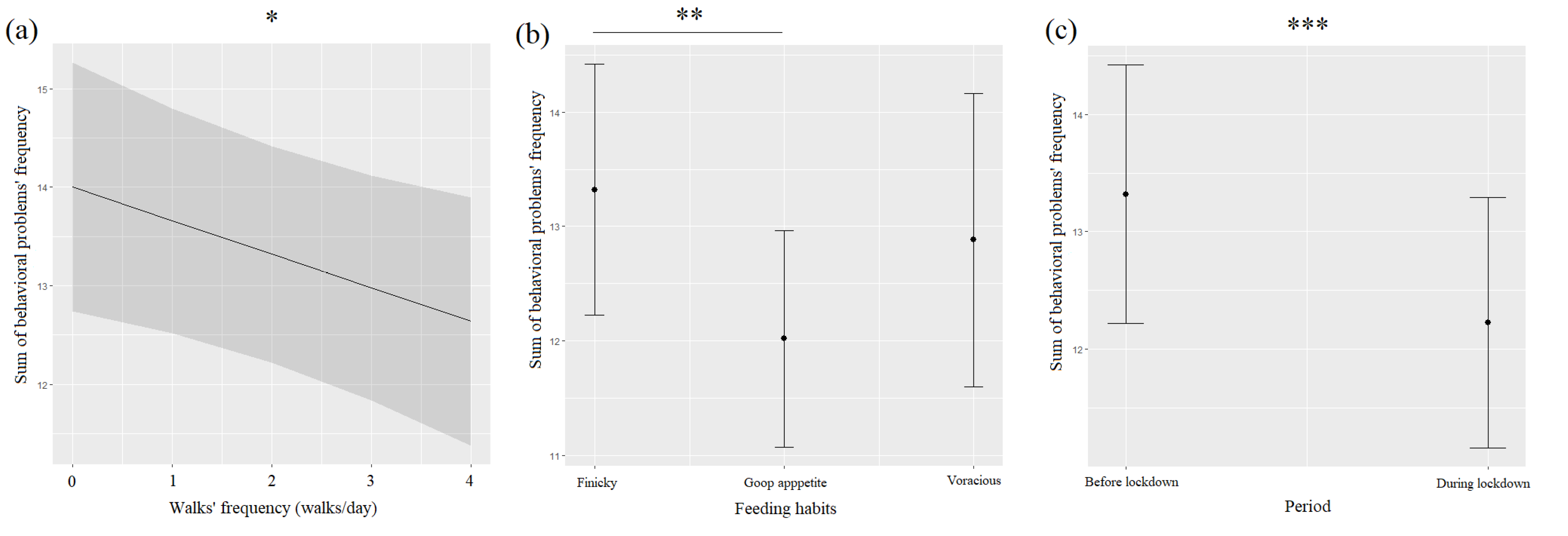
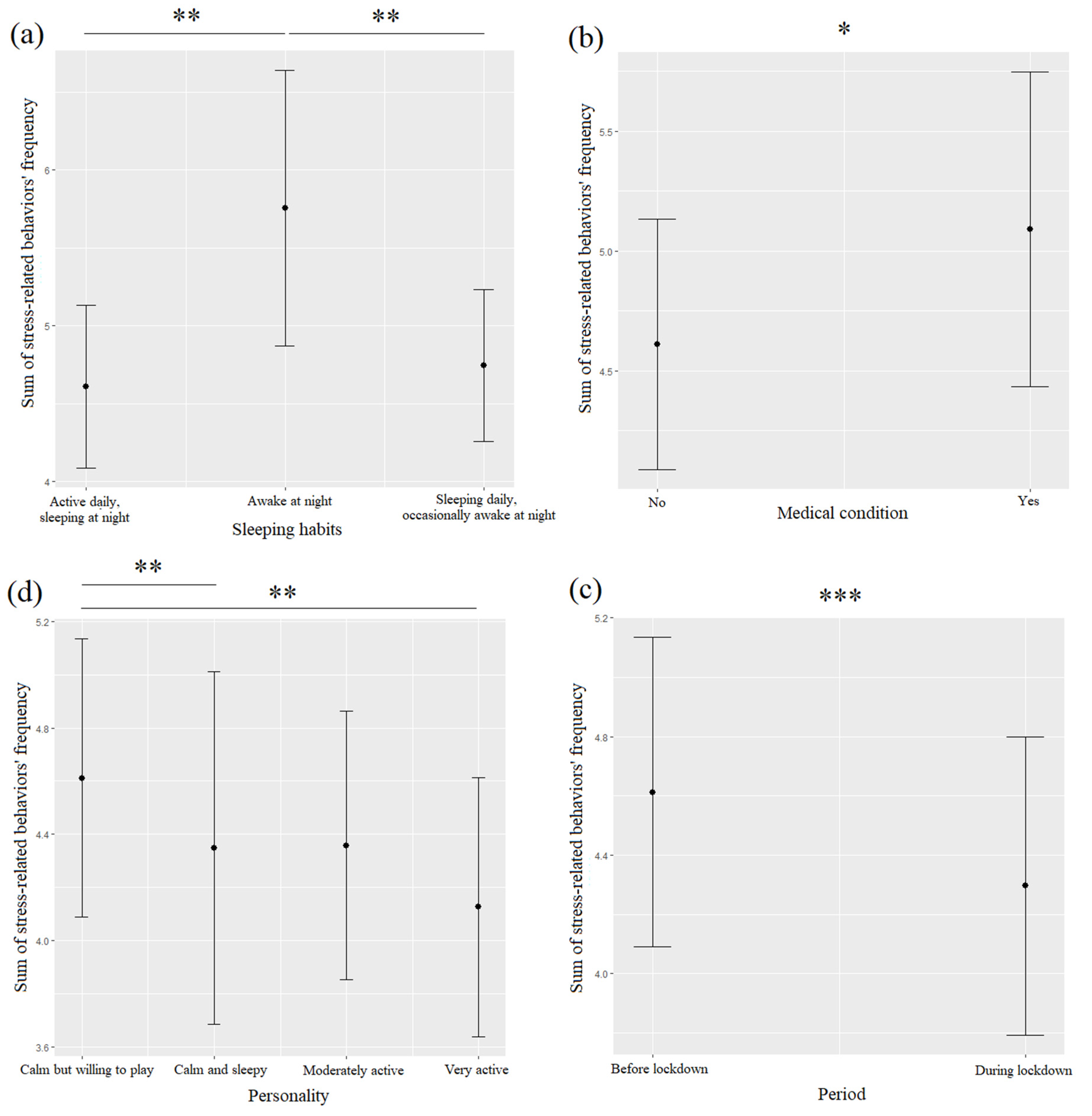
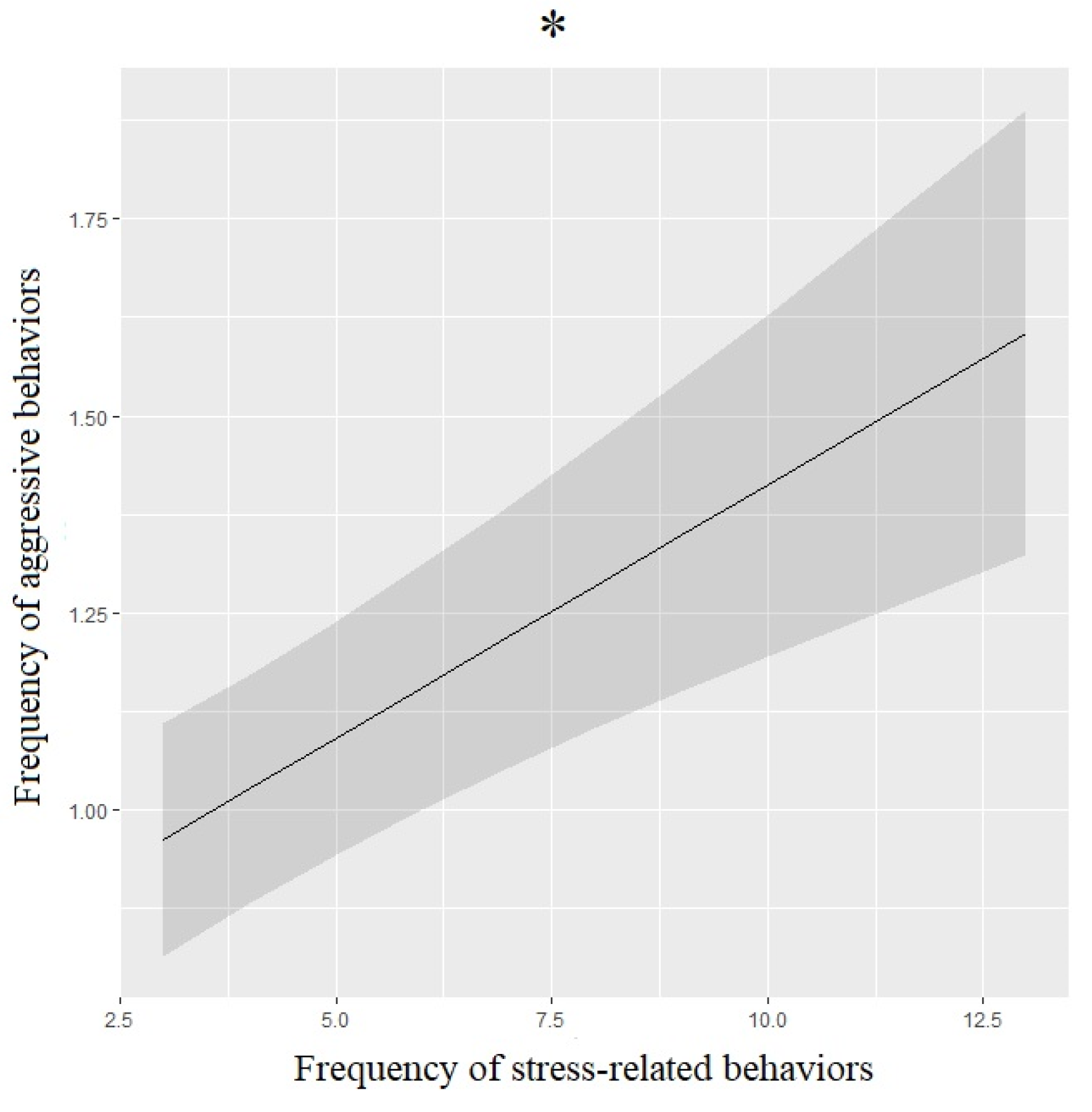

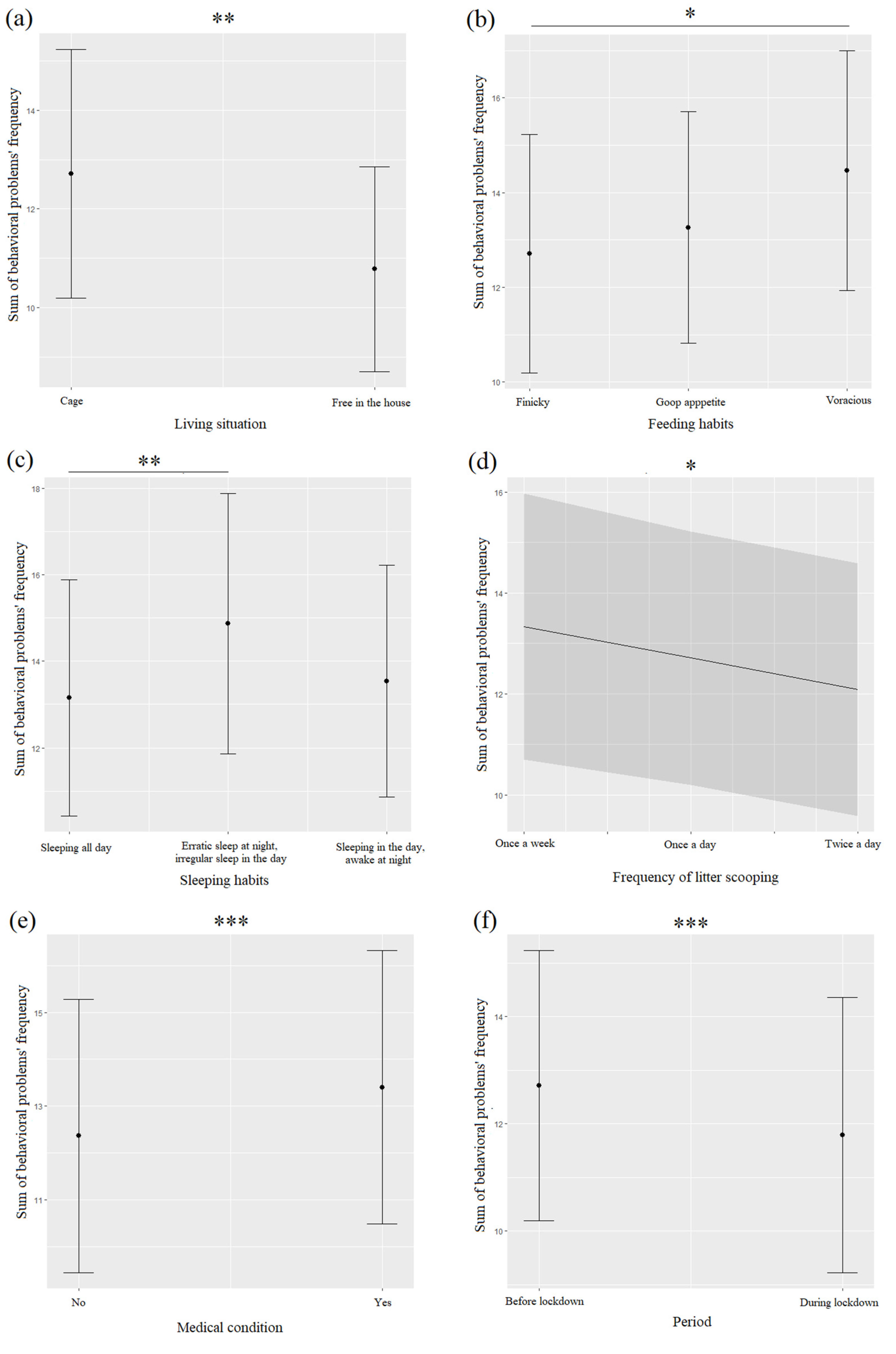
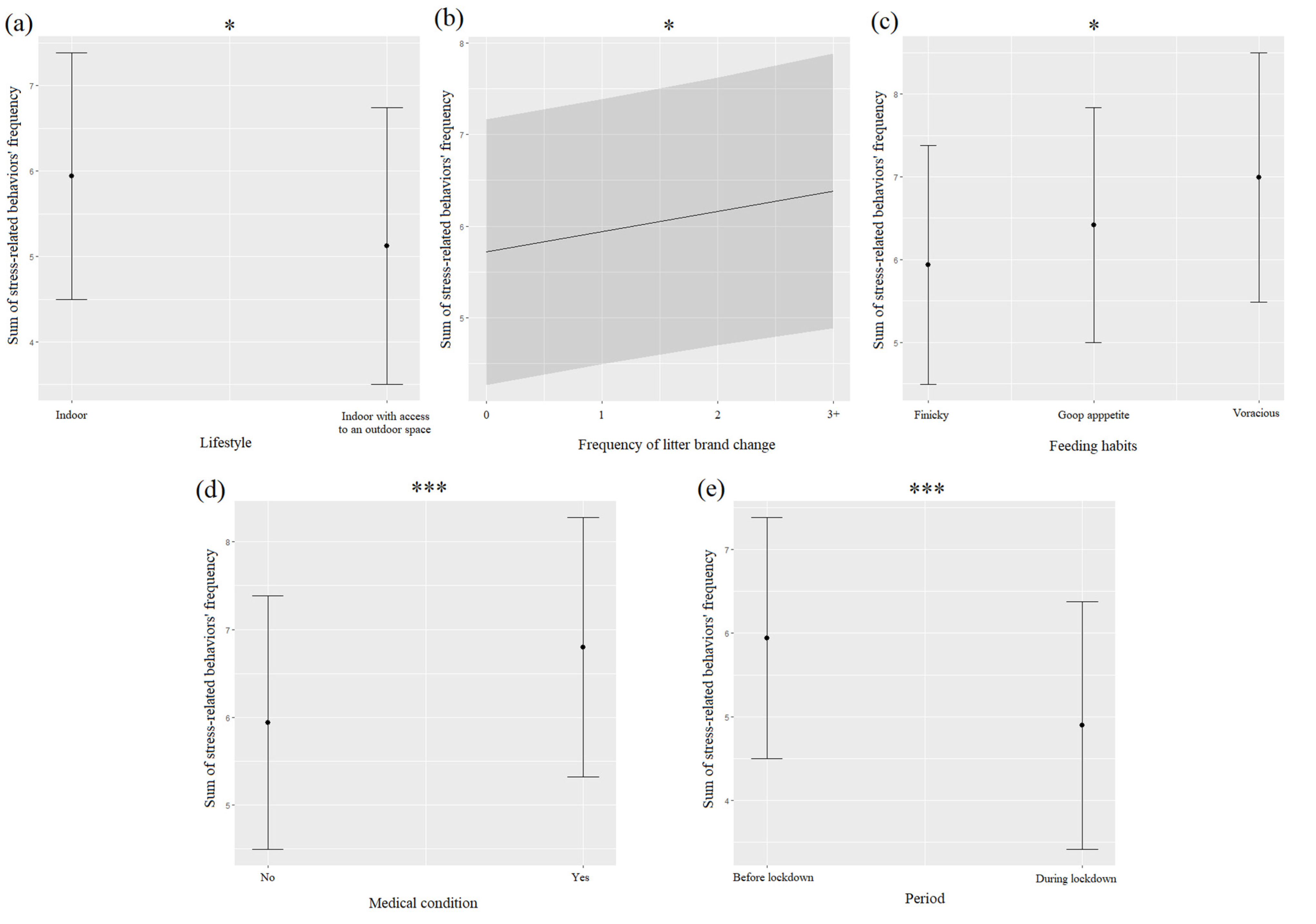
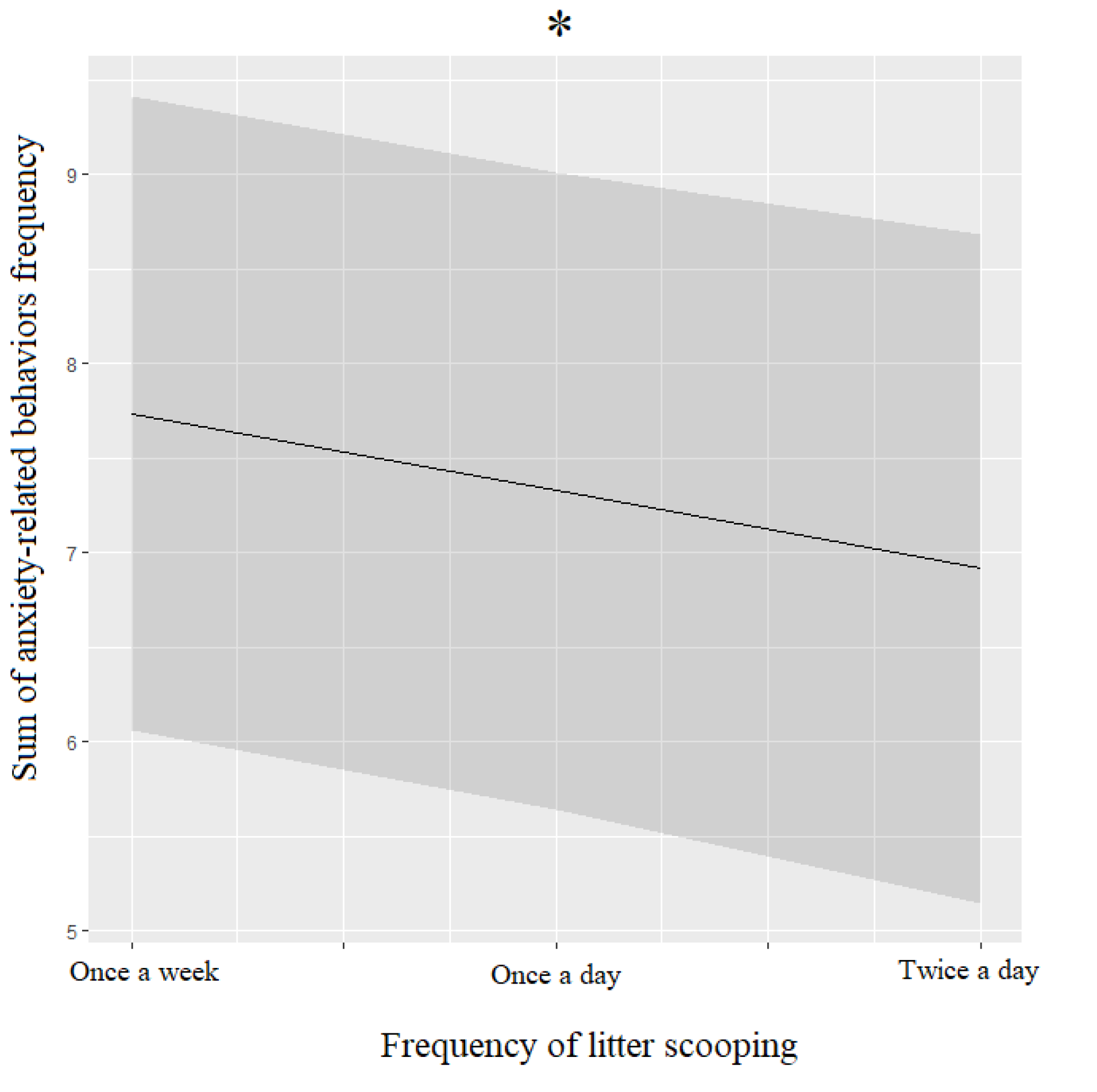
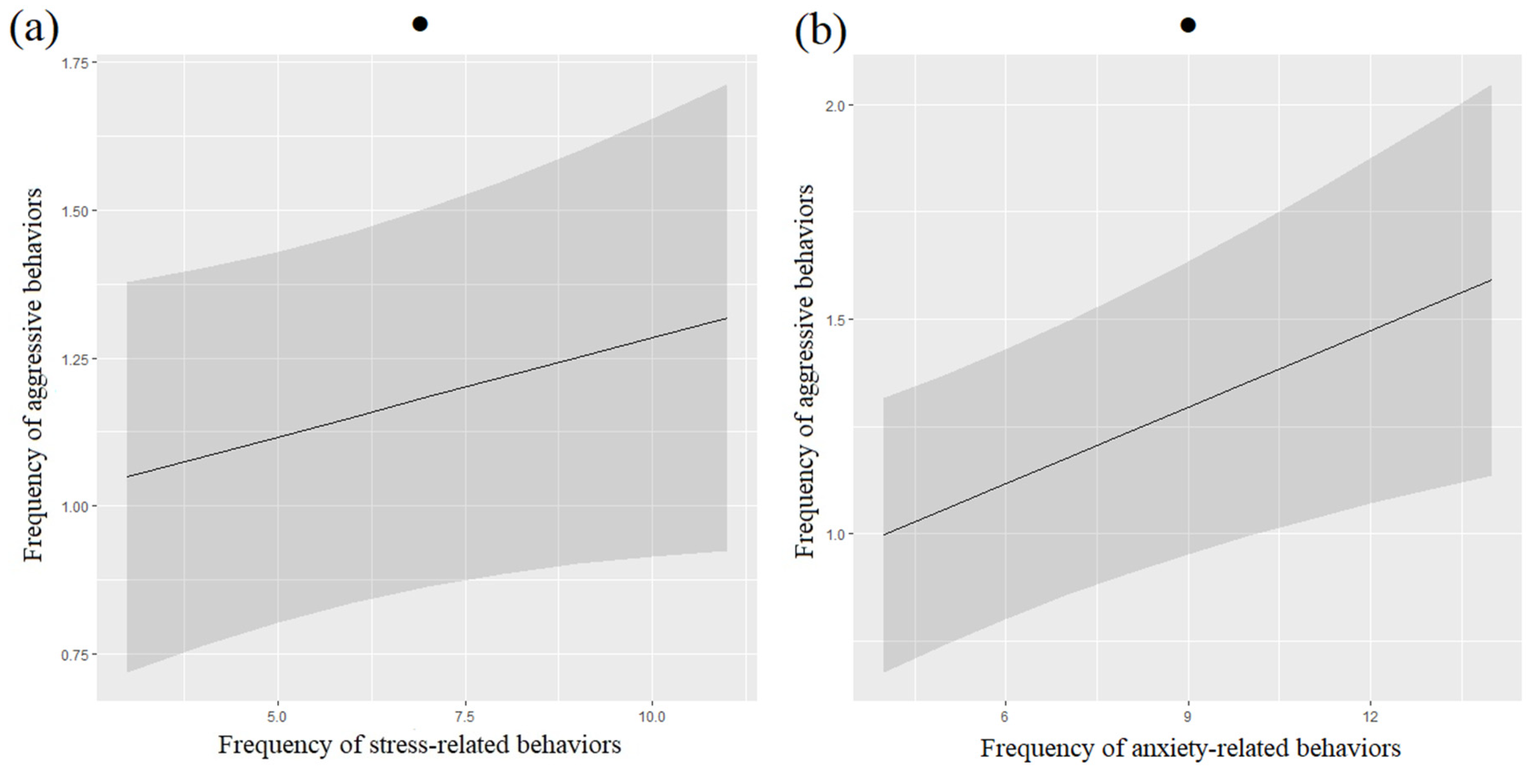

| (a) Dog’s Medical Conditions | Specified by the Owner |
| Dog’s living situation | Free to move in the house Kept in a crate for most or part of the day Kept in the garden with chances to move inside the house Kept on a terrace with chances to move inside the house |
| Dog’s sleeping habits | Sleeps more during the day/occasionally awakens at night Awake all night Active during the day/sleep at night |
| Dog’s feeding habits | Finicky, good appetite, voracious |
| Dog’s play activity | 1 h/day, 30 min/day, 10 min/day, only when have time |
| Behavioral problems [42] | House soiling (urination/defecation) Excessive barking Howling Destructiveness (chewing furniture, scratching, digging) Overly submissive behavior Excessive excitability/impulse control deficit Aggressive towards family members/biting Fear of people |
| Stress-related behaviors [42] | Hiding Intense shedding Visible dandruff |
| Anxiety-related behaviors [42] | Episodes of yawing Episodes of nose licking Episodes of grooming Episodes of panting/body tense |
| (b) Cat’s Lifestyle | Indoor Only Partially Indoor/Partially Outdoor |
| Cat’s medical conditions | Specified by the owner |
| Cat’s living situation | Free to move in the house Kept in cage and let out few hours a day |
| Cat’s sleeping habits | Sleeps during the day/awake at night Erratic nocturnal pattern/irregular daytime pattern Sleeps around the clock |
| Number of litter boxes | 0, 1–2, 3–4, 5+ |
| Changes of litter brand (number of times) | 0, 1, 2, 3+ |
| Litter refilling | Once a week, twice a week, once a month |
| Scooping litter | Once a day, twice a day, once a week |
| Cat’s feeding habits | Finicky, good appetite, voracious |
| Cat’s play activity | 30 min/day, 10 min/day, only when have time |
| Cat’s personality (before and during lockdown) | Social Limited social Fearful Hiding all the time |
| Behavioral problems [42] | Urine spraying Inappropriate elimination (feces/urine) Destructive behaviors (chewing, scratching) Aggressive behaviors/biting |
| Stress-related behaviors [42] | Hiding Intense shedding Visible dandruff |
| Anxiety-related behaviors [42] | Episodes of yawing Episodes of howling Episodes of meowing Episodes of pacing around the house |
| (a) Dogs | Variables | Levels |
| Response variables | Behavioral problems | – |
| Stress-related behaviors | – | |
| Anxiety-related behaviors | – | |
| Predictors | Family members | 1–2/3–4/≥5 |
| Living situation | Cage/free in the house/garden/terrace | |
| Walks frequency | 0–4 times a day | |
| Feeding frequency | Once a day/twice a day/anytime | |
| Food type | Dog food/table scraps | |
| Feeding habits | Finicky/good appetite/voracious | |
| Sleeping habits | Active daily, sleeping at night/sleeping daily, occasionally awake at night/awake at night | |
| Time spent playing | Never/10 min a day/when have time/30 min a day/1 h a day | |
| Medical condition | Yes/no | |
| Personality | Very calm/calm but willing to play/moderately active/very active | |
| Lockdown type | Flexible/medium/strict | |
| Period | Before lockdown/during lockdown | |
| Random factors | Individual | Individual ID |
| Breed | Individual breed | |
| Sex | Female/male | |
| Age | Puppy/adolescent/adult/senior | |
| (b) Cats | ||
| Response variables | Behavioral problems | – |
| Stress-related behaviors | – | |
| Anxiety-related behaviors | – | |
| Predictors | Family members | 1–2/2–3/≥5 |
| Living situation | Cage with opportunity to go out occasionally/free in the house | |
| Lifestyle | Indoor/indoor and outdoor | |
| Feeding habits | Finicky/good appetite/voracious | |
| Sleeping habits | Sleeping around the clock/sleeping daily, occasionally awake at night/eratic nocturnal pattern and irregular daytime pattern | |
| Number of litter boxes | 1–5 | |
| Frequency of litter brand change | 0–3+ | |
| Frequency of litter refilling | Twice a week/once a week/once a month | |
| Frequency of litter scooping | Twice a day/once a day/once a week | |
| Time spent playing | Never/10 min a day/when have time/30 min a day/1 h a day | |
| Medical condition | Yes/no | |
| Personality | Fearful/limited social/social | |
| Lockdown type | Flexible/medium/strict | |
| Period | Before lockdown/during lockdown | |
| Random factors | Individual | Individual ID |
| Breed | Individual breed | |
| Sex | Female/male | |
| Age | Kitten/junior/prime/mature/geriatric |
| Response Variable | Behavioral Problems | Stress-Related Behaviors | Anxiety-Related Behaviors | |
|---|---|---|---|---|
| Predictors | Family members | χ² = 2.86, df = 2, p = 0.505 | χ² = 1.33, df = 2, p = 0.536 | χ² = 1.24, df = 2, p = 0.455 |
| Living situation | χ² = 2.93, df = 3, p = 0.402 | χ² = 3.04, df = 3, p = 0.386 | χ² = 1.54, df = 3, p = 0.672 | |
| Walks frequency | χ² = 4.93, df = 1, p = 0.026 | χ² = 0.23, df = 1, p = 0.634 | χ² = 0.30, df = 1, p = 0.586 | |
| Feeding frequency | χ² = 0.04, df = 1, p = 0.837 | χ² = 0.06, df = 1, p = 0.796 | χ² = 0.99, df = 1, p = 0.320 | |
| Food type | χ² = 1.75, df = 1, p = 0.186 | χ² = 1.44, df = 1, p = 0.230 | χ² = 2.26, df = 1, p = 0.133 | |
| Feeding habits | χ² = 10.27, df = 2, p = 0.006 | χ² = 4.60, df = 2, p = 0.099 | χ² = 1.62, df = 2, p = 0.443 | |
| Sleeping habits | χ² = 3.15, df = 2, p = 0.207 | χ² = 6.25, df = 2, p = 0.0438 | χ² = 4.64, df = 2, p = 0.098 | |
| Time spent playing | χ² = 0.04, df = 1, p = 0.838 | χ² = 0.96, df = 1, p = 0.326 | χ² = 5.83, df = 1, p = 0.016 | |
| Medical condition | χ² = 0.74, df = 1, p = 0.391 | χ² = 4.02, df = 1, p = 0.045 | χ² = 0.04, df = 1, p = 0.845 | |
| Personality | χ² = 4.09, df = 3, p = 0.252 | χ² = 5.99, df = 3, p = 0.112 | χ² = 2.30, df = 3, p = 0.513 | |
| Lockdown type | χ² = 0.68, df = 2, p = 0.712 | χ² = 2.01, df = 2, p = 0.367 | χ² = 0.01, df = 2, p = 0.997 | |
| Period | χ² = 26.63, df = 1, p < 0.001 | χ² = 13.44, df = 1, p < 0.001 | χ² = 0.05, df = 1, p = 0.832 | |
| Lockdown type * period | χ² = 2.93, df = 3, p = 0.402 | χ² = 1.21, df = 2, p = 0.547 | χ² = 1.16, df = 2, p = 0.560 |
| Response Variable | Aggressive Behaviors | Bites | |
|---|---|---|---|
| Predictors | Family members | χ² = 0.92, df = 2, p = 0.631 | χ² = 0.58, df = 2, p = 0.748 |
| Lockdown type | χ² = 0.13, df = 2, p = 0.936 | χ² = 0.14, df = 2, p = 0.933 | |
| Period | χ² = 0.22, df = 1, p = 0.643 | χ² = 2.61, df = 1, p = 0.106 | |
| Stress-related behaviors | χ² = 4.64, df = 1, p = 0.031 | χ² = 1.19, df = 1, p = 0.274 | |
| Anxiety-related behaviors | χ² = 0.84, df = 1, p = 0.360 | χ² = 1.30, df = 1, p = 0.253 |
| Response Variable | Behavioral Problems | Stress-Related Behaviors | Anxiety-Related Behaviors | |
|---|---|---|---|---|
| Predictors | Family members | χ² = 1.75, df = 2, p = 0.525 | χ² = 1.23, df = 2, p = 0.359 | χ² = 0.86, df = 2, p = 0.477 |
| Living situation | χ² = 7.58, df = 1, p = 0.006 | χ² = 0.88, df = 1, p = 0.348 | χ² = 3.36, df = 1, p = 0.066 | |
| Lifestyle | χ² = 0.87, df = 1, p = 0.351 | χ² = 4.93, df = 1, p = 0.026 | χ² = 1.02, df = 1, p = 0.311 | |
| Feeding habits | χ² = 5.95, df = 2, p = 0.051 | χ² = 6.89, df = 2, p = 0.032 | χ² = 5.79, df = 2, p = 0.055 | |
| Sleeping habits | χ² = 4.83, df = 2, p = 0.089 | χ² = 2.19, df = 2, p = 0.334 | χ² = 0.21, df = 2, p = 0.89 | |
| Number of litter boxes | χ² = 0.01, df = 1, p = 0.912 | χ² = 0.01, df = 1, p = 0.911 | χ² = 0.44, df = 1, p = 0.506 | |
| Frequency of litter brand change | χ² = 0.69, df = 1, p = 0.406 | χ² = 5.77, df = 1, p = 0.016 | χ² = 0.49, df = 1, p = 0.484 | |
| Frequency of litter refilling | χ² = 0.87, df = 1, p = 0.351 | χ² = 0.03, df = 1, p = 0.869 | χ² = 2.68, df = 1, p = 0.101 | |
| Frequency of litter scooping | χ² = 5.10, df = 1, p = 0.024 | χ² = 0.03, df = 1, p = 0.859 | χ² = 5.20, df = 1, p = 0.022 | |
| Time spent playing | χ² = 2.23, df = 1, p = 0.136 | χ² = 0.00, df = 1, p = 0.973 | χ² = 1.76, df = 1, p = 0.184 | |
| Medical condition | χ² = 11.08, df = 1, p < 0.001 | χ² = 11.25, df = 1, p < 0.001 | χ² = 0.83, df = 1, p = 0.362 | |
| Personality | χ² = 2.89, df = 2, p = 0.235 | χ² = 5.20, df = 2, p = 0.074 | χ² = 0.09, df = 2, p = 0.955 | |
| Lockdown type | χ² = 0.87, df = 2, p = 0.648 | χ² = 3.06, df = 2, p = 0.216 | χ² = 0.09, df = 2, p = 0.952 | |
| Period | χ² = 24.73, df = 1, p < 0.001 | χ² = 38.33, df = 1, p < 0.001 | χ² = 0.12, df = 1, p = 0.730 | |
| Lockdown type * period | χ² = 1.46, df = 2, p = 0.483 | χ² = 1.08, df = 2, p = 0.583 | χ² = 3.29, df = 2, p = 0.193 |
| Response Variable | Aggressive Behaviors | Bites | |
|---|---|---|---|
| Predictors | Family members | χ² = 5.66, df = 2, p = 0.069 | χ² = 0.90, df = 2, p = 0.956 |
| Frequency of litter change | χ² = 0.14, df = 1, p = 0.709 | χ² = 3.29, df = 1, p = 0.069 | |
| Lockdown type | χ² = 0.37, df = 2, p = 0.829 | χ² = 0.06, df = 2, p = 0.967 | |
| Period | χ² = 2.61, df = 1, p = 0.106 | χ² = 0.02, df = 1, p = 0.902 | |
| Stress-related behaviors | χ² = 3.19, df = 1, p = 0.074 | χ² = 2.47, df = 1, p = 0.116 | |
| Anxiety-related behaviors | χ² = 3.66, df = 1, p = 0.055 | χ² = 0.23, df = 1, p = 0.628 |
Publisher’s Note: MDPI stays neutral with regard to jurisdictional claims in published maps and institutional affiliations. |
© 2022 by the authors. Licensee MDPI, Basel, Switzerland. This article is an open access article distributed under the terms and conditions of the Creative Commons Attribution (CC BY) license (https://creativecommons.org/licenses/by/4.0/).
Share and Cite
Platto, S.; Serres, A.; Normando, S.; Wang, Y.; Turner, D.C. Changes in the Dog’s and Cat’s Behaviors, as Reported by the Owners, before and during the Lockdown in China. Animals 2022, 12, 2596. https://doi.org/10.3390/ani12192596
Platto S, Serres A, Normando S, Wang Y, Turner DC. Changes in the Dog’s and Cat’s Behaviors, as Reported by the Owners, before and during the Lockdown in China. Animals. 2022; 12(19):2596. https://doi.org/10.3390/ani12192596
Chicago/Turabian StylePlatto, Sara, Agathe Serres, Simona Normando, Yanqing Wang, and Dennis C. Turner. 2022. "Changes in the Dog’s and Cat’s Behaviors, as Reported by the Owners, before and during the Lockdown in China" Animals 12, no. 19: 2596. https://doi.org/10.3390/ani12192596
APA StylePlatto, S., Serres, A., Normando, S., Wang, Y., & Turner, D. C. (2022). Changes in the Dog’s and Cat’s Behaviors, as Reported by the Owners, before and during the Lockdown in China. Animals, 12(19), 2596. https://doi.org/10.3390/ani12192596






